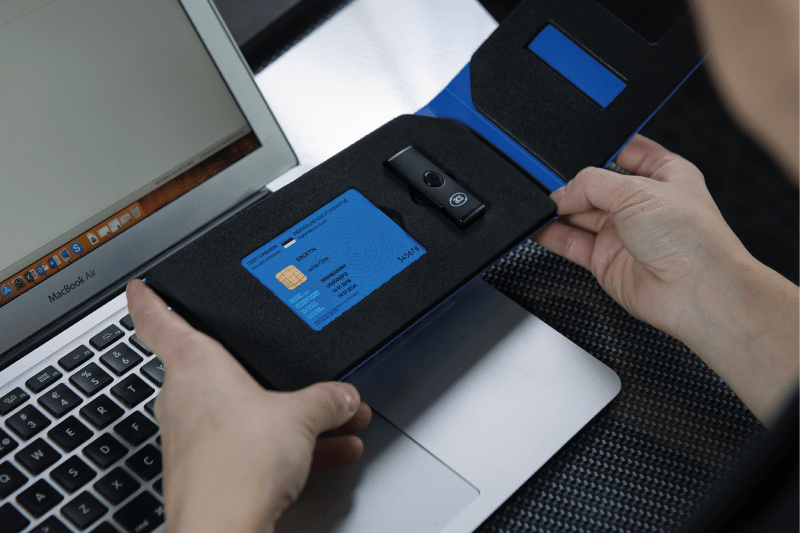What is Estonian e-Residency?
The Estonian e-Residency is an innovative idea of the modern digital world. In fact, Estonia was the first country ever to offer such a program upon launch in 2014. The Estonian Government designed the program with hopes to attract investments and new entrepreneurs to the new digital nation. Being part of the e-Residency program enables non-residents and other global citizens to be part of the Estonian and the European economy.
The e-Residency card itself is a government-issued digital identity card that gives access to the digital business environment, where forming and managing a company has never been easier. You can do it without the need to be present in Estonia, as it is a form of digital identification. With it, you can digitally sign documents and interact with all the government services.
Incorporate is ready to help you! Please feel free to reach out to us if you would like to get more information about any of our company formation & management services or accounting services.
Who needs Estonian e-Residency?
Estonian e-Residency is perfect for location-independent entrepreneurs, who are looking to run a company that supports their international lifestyle. It provides a gateway to gain temporary residency with an innovative and scalable start-up that may have a promising future in business.
People who can benefit from the Estonian e-Residency are:
- freelancers, who work independently for different clients around the world;
- start-up company founders, who wish to be part of the Estonian business ecosystem and the Start-up Visa program;
- entrepreneurs, who are looking to expand their current businesses to the European market;
- entrepreneurs, want like to go paperless and reduce bureaucracy;
- people, who wish to connect with like-mineded entrepreneurs.
Estonia is the perfect business location for people who are looking to work in a transparent and safe business environment along with technology that government has built for everyday business effectiveness – the ease of conducting business is achieved through the lack of bureaucratic regulations that lower with the digital infrastructure.
Estonian e-Residency benefits
There are many ways that e-Residency simplifies your business activities in Estonia and in Europe. The primary benefit of the digital identity card giving you easy access to all public e-services, allowing you to operate fully digitally.
Furthermore, as the Republic of Estonia is part of the European Union, having an Estonian company gives better chances for cooperation and competitiveness within the European Economic Area. Even the Estonian tax system favours entrepreneurs and has amazing investment opportunities in relation to the program.
Start and manage EU company online
For most people, the management of an Estonian company, which is completely location-independent, and the easy company registration process, are the key motivators to become an e-resident. Believe it or not, an Estonian company formation process with the Digital ID card could be as quick as 15 minutes.
Once you have established your company, you can manage it remotely by using the Estonian e-services, which allows almost everything to be done online. Those e-services enable all e-residents to continue managing their businesses with no hassle or unnecessary paperwork.
This is especially good in cases where a company will have remote founders and remote workers, as gaining access and identification can always be done securely and effectively over distance.
Authenticate yourself and and sign documents remotely
Now, with your e-Residency card, you will also be able to perform all your business-related administrative processes remotely and even sign documents remotely. For each of these actions, you will have different PIN codes.
PIN 1 is used for authentication, and PIN 2 is to sign documents. All this is made possible by the secure e-services that are interlinked and use your digital ID-card to identify you virtually. Digitally signed documents can be later sent out to other parties over the internet, thus making it much more efficient in terms of time, safety, and money, instead of the traditional way of sending documents by mail or courier.
With your new ID card, you cannot only sign documents but also verify the authenticity of the signatures that others have made on the documents that have been signed.
Please click here to find out more information about getting started with your e-Residency card and using it to sign documents.
Simple and fair taxation
When it comes to corporate taxes, the system is more than fair. As a tax resident in Estonia, the corporate income tax rate is 0% on all profits that are retained and kept within the company. The CIT applies only when the dividends are paid out to the shareholders, and the tax rate for that is 20%.
In case you have employees in your company that work in Estonia, you must pay taxes on having them as well. The country where you must pay taxes on your employees depends on where your employees have their tax residency. In case your employee is an Estonian tax resident, you as the employer are liable to pay social tax to the tax office.
The current social tax rate is 33%. The employee is liable to pay the income tax on their salary, which is currently 20%. The income tax is withheld and paid to the state by the employer.
To find out more about the specifics of taxes in Estonia, please click here!
E-Residency marketplace
Since the Estonian e-Residency program enables entrepreneurs to create and manage companies remotely, there has emerged a special niche that helps those business owners to do it effectively and securely.
Those are service providers in that niche offer things like a virtual office, tax consulting, accounting, and legal services. These service providers often charge a monthly or a yearly fee for their services, and many business owners choose to collaborate with them, as they can get legal advice as well.
E-Residency statistics
According to the government statistics, as of September 2022, there are around 95,000 Estonian e-residents from all around the world. Together, these people have started over 22,000 Estonian companies. People from Russia, Ukraine and Germany have founded the biggest number of companies in Estonia as e-residents.
The 5 most popular countries from where recent e-Residency applicants are from, are Spain, Ukraine, Germany, France and China, showing that the program is popular within and outside of the European borders.
Most popular businesses established by e-Residents are in the fields of computer programming, consultancy and related activities.
How to become an e-resident?
Luckily, the steps you need to take to become an Estonian e-resident are easy and the application process is straightforward. There are only a few things that you need to consider beforehand.
Since you will be able to do almost everything online when you have your Estonian e-Residency card, it is not surprising that the same goes for the application.
Requirements
Anyone in the world is welcome to become a part of the government program for e-residents if they have genuine and reasonable interest in using Estonia’s e-services.
As such, there are no real requirements to be eligible to become an e-resident, you just have to consider that there will be a background check by the Estonian Police and Border Guard to ensure that all applicants are, who they say they are and that they are not involved in suspicious activities.
In case that you already are an Estonian citizen or have a residence permit in Estonia, you cannot apply for the program, as the local ID-card serves the same purpose as the e-Residency card.
Cost of Estonian e-Residency
The cost of the Estonian e-Residency in total is between €100-€120, which you need to pay as the state fee at the time of the submission of your application. Note that the state fee is variable because of your selected pickup location.
If you will be able to pick up your e-Residency at an office in Estonia, the state fee is €100. If you will collect it at an Estonian embassy or at a representation office in a foreign state, the price will be €120.
Be aware that for certain pickup locations there may be an extra collection fee and the pickup location cannot be changed afterwards.
Application
Before you start the application process, prepare the following documents and information, so everything goes smoothly:
- a copy of your passport or an ID issued by your government
- a digital photo of yourself that would be suitable for a passport
- a motivation letter for becoming an e-resident;
- Visa or Mastercard, which you will use for the state fee payment.
Once you have these documents ready, you can start applying.
E-Residency applications are made by creating a personal account on an Estonian Police and Boarder Guard website where the whole process takes place. On that site, you can pause and continue filling in your application at any time you wish, as long as you submit it within 2 months.
During the application, you must submit some personal information. Near the end of the process, you must choose your e-Residency pickup location. As of September 2022, there are countries 46 around the world, including Estonia, where you can organize your card to be delivered to. Before choosing the location, please make sure that you will not have problems with entering that specific location legally.
The locations where you can organize a pickup are the following:
- Australia, Canberra
- Austria, Vienna
- Azerbaijan, Baku
- Belarus, Minsk
- Belgium, Brussels
- Brazil, São Paulo
- Bulgaria, Sofia (mobile pickup point)
- Canada, Ottawa
- China, Beijing
- Croatia, Zagreb (mobile pickup point)
- Czech Republic, Prague
- Denmark, Copenhagen
- Egypt, Cairo
- Estonia, Tallinn, Tartu, Pärnu and Narva
- Finland, Helsinki
- France, Paris
- Georgia, Tbilisi
- Germany, Berlin
- Greece, Athens
- Hungary, Budapest
- India, New Delhi
- Ireland, Dublin
- Israel, Tel Aviv
- Italy, Rome
- Japan, Tokyo
- Kazakhstan, Nur-Sultan
- Latvia, Riga
- Lithuania, Vilnius
- Netherlands, The Hague
- Norway, Oslo
- Poland, Warsaw
- Portugal, Lisbon
- Romania, Bucharest
- Russian Federation, Moscow
- Singapore, Singapore
- Slovenia, Ljubljana (mobile pickup point)
- South Africa, Pretoria
- South Korea, Seoul
- Spain, Madrid
- Sweden, Stockholm
- Thailand, Bangkok
- Turkey, Ankara
- United Arab Emirates, Abu Dhabi
- United Kingdom, London
- Ukraine, Kyiv
- United States, New York City and San Francisco
After you have submitted your application and paid the state fee, you will get a confirmation email stating the submission of your application.
E-Residency application review
After you have submitted your application, there will be an analysis of your application and a background check by the Estonian Police and Border Guard Board. The background check is done for all e-Residency applicants, regardless of their nationality. The analysis of your application with the background check is said to take around 3 to 8 weeks.
A few weeks after a positive answer, your e-Residency kit should become available for pickup at your chosen location.
If there is any need for additional information, you will be contacted, and this may increase the time that will take to fully review your application.
Receiving your Estonian e-Residency kit
All successful applicants will be given notice by email and invited to the pickup location to collect their Estonian e-Residency kit. In total, you will have 6 months to collect it, starting from the date that they notified you. If you do not collect it within those 6 months, you must apply again and wait for approval.
Many of our customers ask if there is a possibility that someone else can go and pick up the card for them. This is not possible, as the final recipient must do it herself/himself and their identity must be confirmed while doing so. When you are going to your chosen pickup location, make sure you are bringing your passport or ID with you, and prepare to submit your fingerprints.
In case that you are unable to go and pickup your kit at your selected pickup location, you have the possibility to change it. As I mentioned earlier, some locations do not offer the possibility to change your collection point.
If you are possible to change it, you must request the change when you are notified that your card is ready and before it has been sent out to your selected location. In addition to this, you must pay a state fee which the government must receive before the collection point change will be initiated.
The fee for changing the pickup point from one Estonian embassy to another or to an Estonian office is €80, while changing from an Estonian office to an embassy is €30. Also, switching between Estonian offices costs €10.
Within the e-Residency kit that you receive is your new e-Residency card, pin codes, and a smart card reader that you will use to connect the card to your computer. The kit looks like this:

Estonian e-Residency alternatives
As an alternative to the e-Residency program, if you are able, you may get a residence permit through work or studies. This will give you the same e-service opportunities as all the e-residents have. As a resident, you can start a company as easily as mentioned before, but you will have the upper hand by legally living in Estonia and managing your business there.
Another way to gain residency in Estonia is through business. This can be done if you have an operational and profitable business, a holding company or operate as a sole proprietor and have invested in business activities in Estonia. As a sole proprietor, you must invest at least €16,000, and in a bigger business, the threshold is €65,000.
Furthermore, there is a Start-Up Visa program for innovative and scalable tech businesses, which must go through an evaluation process by and committee of experts. If you get approval, you may be granted a temporary residence and a visa.
Digital Nomad Visa program
There is some good news for digital entrepreneurs, digital nomads, and remote workers. From August 2020, there is a possibility to apply for a Digital Nomad Visa, which allows them to gain a temporary residence permit and legally live and stay in Estonia for a year.
- You should apply if:
- you can work remotely;
- you can perform your job duties using telecommunications technology;
- you must have an active employment contract with a company that is registered outside of Estonia, conduct business through your own company that is registered abroad, or work as a freelancer for clients that the majority are not from Estonia;
- you can provide proof that your income is above the minimum threshold (monthly €3504) during the months preceding your application.
Also, there have been rumours that in the future, the government will try to make the Digital Nomad Visa and Estonian e-Residency into one single offering that enables the Visa applicants to enjoy all the comforts that the digital nation offers with its infrastructure.
For more information about the DNV, please click here!
FAQ
Should I become an e-resident?
The answer to this question largely depends on your plans and your intentions related to becoming an Estonian e-resident. If you are planning to establish a company that you can run remotely and with minimal paperwork involved, then you should become one most certainly! Furthermore, an Estonian company gives great access to the European single market for non-EU entrepreneurs, while benefiting from the Estonian business environment.
However, you should remember that being an e-resident is not obligatory in order to start or manage a company.
Can I live in Estonia with e-Residency?
This is one of the most confusing aspects of e-Residency and for people who are just looking into it. It is important to acknowledge that Estonian e-Residency does not give a right for physical or tax residency in Estonia or in Europe, nor does it give the immediate right to enter the EU as a non-EU national.
EU nationals may reside in Estonia for 90 days, after which one has to get a temporary and/or permanent residency. However, as a non-EU national, to live in Estonia, you must have either family ties, be employed by a local company, make an investment, or enroll in a study program. Also, there are visa programs for technology-based start-up founders and digital nomads, which grant legal residency for a certain time period.
For more information about obtaining Estonian temporary and/or permanent residency, please visit the Estonian Police and Border Guard Board’s website.
Which countries offer e-Residency?
Estonia was the first country in the world to introduce the e-Residency program. Since this innovative idea has gained notoriety all over the world, it is only natural that other countries have jumped on the train and started providing their own version of it. Here is a small list of countries that also offer their own e-Residency:
- Estonia, since 2014;
- Georgia, since 2018;
- Azerbaijan, since 2018;
- Lithuania, since 2021.



